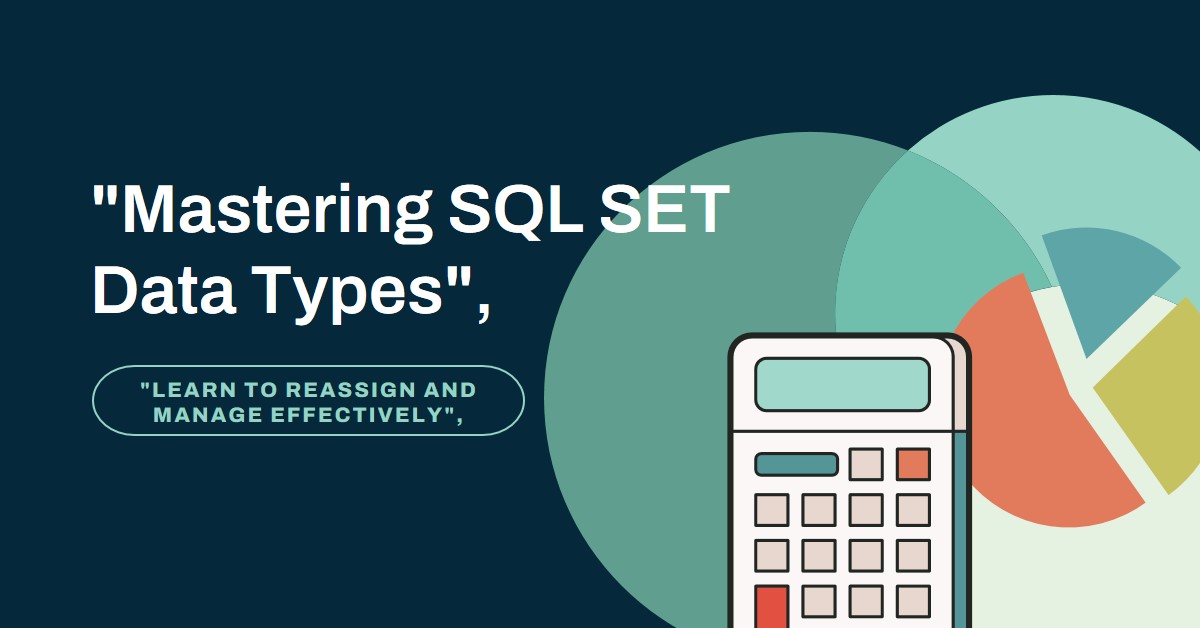Reassigning and Managing the SET Data Type in SQL
The SET data type in SQL is a versatile option for storing multiple predefined values in a single column. However, as database requirements evolve, you may need to reassign or modify the data type of a column initially defined as SET. This blog provides an in-depth look at how to handle such scenarios, including the process of reassignment, best practices, and alternative approaches.
What is the SET Data Type?
The SET data type in SQL is used to store a single string consisting of zero or more predefined values chosen from a list. Each value in the list is unique, and the column can hold any combination of these values. This makes the SET data type highly efficient for storing multiple attributes or options in a compact manner.
Key Features of the SET Data Type:
- Predefined Values: You define a fixed list of values when creating the column.
- Multiple Selections: A SET column can store any combination of the predefined values.
- Compact Storage: Uses bit mapping to store combinations efficiently.
- Case Sensitivity: SET values are case-insensitive by default but can vary based on collation.
- Maximum Limit: A column can have up to 64 distinct values.
Example:
CREATE TABLE UserPreferences (
UserID INT PRIMARY KEY,
Hobbies SET('Reading', 'Traveling', 'Cooking', 'Sports')
);
In this example, the Hobbies column allows users to select any combination of the predefined hobbies.
Why Modify or Reassign the SET Data Type?
While the SET data type offers advantages like compact storage and predefined value integrity, certain limitations can necessitate changes:
- Expanding the List of Values: SET columns support up to 64 values. If your use case exceeds this limit, you might need a different approach.
- Adding New Attributes: Modifying the predefined values in a SET column requires schema changes, which can disrupt applications.
- Improved Flexibility: Alternatives like ENUM, JSON, or many-to-many relationships offer more flexibility for evolving requirements.
Steps to Reassign the SET Data Type
Reassigning or modifying a SET data type column involves altering the table schema. Here are the steps:
1. Backup Your Data
Always create a backup of your database before making structural changes.
SELECT * INTO Backup_Table FROM Original_Table;
2. Export and Modify the Data
Extract the existing data for the column you want to modify.
SELECT ID, SET_Column FROM Original_Table;
Modify the extracted data to match the new data type requirements.
3. Alter the Table Schema
Use the ALTER TABLE statement to change the column data type. For example, to change a SET column to a VARCHAR, JSON, or NUMERIC column:
Example: Change to VARCHAR
ALTER TABLE Original_Table
CHANGE SET_Column New_Column_Name VARCHAR(255);
Example: Change to JSON
ALTER TABLE Original_Table
CHANGE SET_Column New_Column_Name JSON;
Example: Change to NUMERIC
ALTER TABLE Original_Table
CHANGE SET_Column New_Column_Name NUMERIC(10, 2);
4. Reinsert Modified Data
If the data structure has changed, update the table with modified values.
UPDATE Original_Table
SET New_Column_Name = 123.45
WHERE ID = 1;
Best Practices for Reassigning the SET Data Type
- Plan for Scalability: Consider alternatives like JSON for dynamic or large datasets.
- Document Changes: Maintain records of schema changes for future reference.
- Test Before Deployment: Validate the data migration and schema updates in a staging environment before applying them to production.
Alternative Approaches to the SET Data Type
If the SET data type no longer fits your use case, consider these alternatives:
1. ENUM
Use ENUM for single predefined values. Suitable for columns that don’t require multiple selections.
ALTER TABLE Original_Table
CHANGE SET_Column New_Column_Name ENUM('value1', 'value2', 'value3');
2. JSON
Store multiple values in a JSON column for greater flexibility.
ALTER TABLE Original_Table
CHANGE SET_Column New_Column_Name JSON;
3. Many-to-Many Relationships
Normalize your database design by using a separate table to store relationships.
Example:
Original Structure:
CREATE TABLE UserPreferences (
UserID INT,
Hobbies SET('Reading', 'Traveling', 'Cooking')
);
Normalized Structure:
CREATE TABLE Users (
UserID INT PRIMARY KEY,
UserName VARCHAR(255)
);
CREATE TABLE Hobbies (
HobbyID INT PRIMARY KEY,
HobbyName VARCHAR(255)
);
CREATE TABLE UserHobbies (
UserID INT,
HobbyID INT,
PRIMARY KEY (UserID, HobbyID)
);
Practical Example: Migrating SET to JSON
Step 1: Export Data
SELECT UserID, Hobbies FROM UserPreferences;
Step 2: Alter Table
ALTER TABLE UserPreferences
CHANGE Hobbies HobbiesJSON JSON;
Step 3: Update Data
UPDATE UserPreferences
SET HobbiesJSON = '["Reading", "Traveling"]'
WHERE UserID = 1;
Step 4: Validate Changes
SELECT * FROM UserPreferences;



